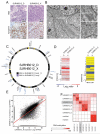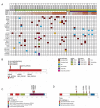Targeting oxidative stress in embryonal rhabdomyosarcoma
- PMID: 24332040
- PMCID: PMC3904731
- DOI: 10.1016/j.ccr.2013.11.002
Targeting oxidative stress in embryonal rhabdomyosarcoma
Abstract
Rhabdomyosarcoma is a soft-tissue sarcoma with molecular and cellular features of developing skeletal muscle. Rhabdomyosarcoma has two major histologic subtypes, embryonal and alveolar, each with distinct clinical, molecular, and genetic features. Genomic analysis shows that embryonal tumors have more structural and copy number variations than alveolar tumors. Mutations in the RAS/NF1 pathway are significantly associated with intermediate- and high-risk embryonal rhabdomyosarcomas (ERMS). In contrast, alveolar rhabdomyosarcomas (ARMS) have fewer genetic lesions overall and no known recurrently mutated cancer consensus genes. To identify therapeutics for ERMS, we developed and characterized orthotopic xenografts of tumors that were sequenced in our study. High-throughput screening of primary cultures derived from those xenografts identified oxidative stress as a pathway of therapeutic relevance for ERMS.
Copyright © 2013 Elsevier Inc. All rights reserved.
Figures







Comment in
-
RAS and ROS in rhabdomyosarcoma.Cancer Cell. 2013 Dec 9;24(6):689-91. doi: 10.1016/j.ccr.2013.11.015. Cancer Cell. 2013. PMID: 24332036 Free PMC article.
References
-
- Barr FG. Chromosomal translocations involving paired box transcription factors in human cancer. The international journal of biochemistry & cell biology. 1997;29:1449–1461. - PubMed
-
- Bouitbir J, Charles AL, Echaniz-Laguna A, Kindo M, Daussin F, Auwerx J, Piquard F, Geny B, Zoll J. Opposite effects of statins on mitochondria of cardiac and skeletal muscles: a 'mitohormesis' mechanism involving reactive oxygen species and PGC-1. European heart journal. 2012;33:1397–1407. - PMC - PubMed
-
- Butler LM, Zhou X, Xu WS, Scher HI, Rifkind RA, Marks PA, Richon VM. The histone deacetylase inhibitor SAHA arrests cancer cell growth, up-regulates thioredoxin-binding protein-2, and down-regulates thioredoxin. Proceedings of the National Academy of Sciences of the United States of America.2002. pp. 11700–11705. - PMC - PubMed
Publication types
MeSH terms
Grants and funding
LinkOut - more resources
Full Text Sources
Other Literature Sources
Research Materials
Miscellaneous

